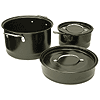More information on fly fishing vest
This is a good fishing site
Coleman Family Cookset
 Coleman Family Cookset is one of many products in the LandBigFish.com fishing tackle and outdoors store.
Coleman Family Cookset is one of many products in the LandBigFish.com fishing tackle and outdoors store.Price: 32.99
A post about fishing
Halloween Fly Fishing - The Ultimate Bite
Halloween and fly fishing may seem like an odd mix, but not for true anglers. Yep, I'm talking about the ultimate test of your abilities and nerve.
Dracula's River
Okay, everyone knows the story of Count Dracula. The book is huge and has be ...
Author: Nomad Rick
An interesting fishing read
Care And Repair Of Fishing Lures
Author: Keith Lee
After buying or making the fishing lures there is still the responsibility of taking care of and repairing them so that they are always in good condition. This requires some effort and time but is usually easy for the angler who makes his own fishing lures. Since he makes them and puts them together, he also knows how to take them apart and repair them. He also has the tools and fishing lure parts necessary for such work. All the tools required to assemble the parts and make the lures are explained on his page at http://www.make-your-own-fishing-lures.com/hand-tools.html " target=new> http://www.make-your-own-fishing-lures.com/hand-tools.html . Fishing lures in general do not require much care when storing them in a home or shop. The best idea is to put them into cabinet drawers or individual boxes so that they can be found easily and can be kept dry. In humid climates or near the seashore it is important not to expose the metal parts to the air; otherwise, hooks will rust and other metals will corrode. Fishing lures that have feathers or hair should be kept in airtight containers so that moths and other insects or small animals will not get to them. This also applies to new fishing lures that haven't yet been used. Lures which have been used require considerable care if you want to get the maximum use from them. Freshwater fishing lures usually require less care and repair than saltwater ones. In general, when examining any fishing lure you have made or bought it's a wise policy to repair it if you are the least bit doubtful about its condition. Repairing usually means sandpapering the part of the lure body that is slightly chipped and then touching up with a small brush, using enamels or lacquers. Replace the hooks with new ones if they are badly rusted. When doing this it is important to use the same size and weight as the old ones so that the action of the fishing lure is not changed in any way. If the damage is too bad and the lure cannot be repaired, throw it away after salvaging any usable parts. It doesn't pay to take chances with a fishing lure that is weak in any way. You may hook a record fish but lose it if the lure is not dependable. Many anglers who buy their fishing lures in tackle stores often use them until they fall apart, before buying new ones. But if you make your own fishing lures you can afford to use only those that are still in good condition. It is better to be safe than sorry. About The Author Keith Lee is a practical, do-it-yourself angler and owns http://Make-Your-own-Fishing-Lures.com " target=new>Make-Your-own-Fishing-Lures.com , an info-packed website on making fishing lures. Learn how to make fishing lures at http://www.make-your-own-fishing-lures.com " target=new> http://www.make-your-own-fishing-lures.com and use it as your trusted guide on home made fishing lures. Feel free to reprint this article in its entirety in your newsletter or on your website so long as you leave all active links in place, do not modify the content and include our resource box as listed here. ...
how to fish
